Calcium Carbonate Dosage Calculator
Feed Formulation Tool
Calculate the optimal calcium carbonate inclusion rate for your animal feed based on species, animal type, and existing calcium content.
Ca:P Ratio Guidelines
Most species thrive on a Ca:P ratio between 1.2:1 and 2:1. Exceeding this range may reduce phosphorus availability.
Poultry layers: 0.8%-1.2% calcium carbonate
Broilers: 0.5%-0.8% calcium carbonate
Swine grow-finish: 0.35%-0.5% calcium carbonate
Lactating sows: up to 0.9% calcium carbonate
Dairy cows: 0.6%-1.0% calcium carbonate
When you hear Calcium carbonate is a mineral supplement derived mainly from limestone that provides a high level of elemental calcium in animal feed, you might think it’s just another ingredient. In reality, it’s a cornerstone of livestock nutrition, balancing bone health, muscle function, and even feed efficiency. This guide walks you through why it matters, how to use it safely, and what to watch out for.
Why Calcium Carbonate Is a Go‑to Calcium Source
Calcium is the most abundant mineral in the body. For livestock, it supports skeletal development, blood clotting, and enzyme activation. Animal feed the mix of nutrients, additives, and binders given to farm animals needs a reliable calcium source, and calcium carbonate checks all the boxes: high calcium content (about 40% elemental Ca), low cost, and excellent stability during pelleting.
Balancing Calcium with Phosphorus and Vitamin D3
Calcium doesn’t work in isolation. The Ca:P ratio is critical; too much calcium can lock up phosphorus, making it unavailable. Most species thrive on a Ca:P ratio between 1.2:1 and 2:1. Adding Vitamin D3 a fat‑soluble vitamin that enhances calcium absorption in the gut to the formula helps the animal utilize both minerals efficiently.
Species‑Specific Inclusion Rates
Different animals have different calcium needs. Below are typical inclusion rates for calcium carbonate in a standard mash or pellet diet (expressed as % of total feed weight):
- Poultry birds raised for meat or eggs: 0.8%-1.2% for layers, 0.5%-0.8% for broilers.
- Swine domestic pigs raised for pork production: 0.35%-0.5% for grow‑finish, up to 0.9% for sows during lactation.
- Dairy cattle cows producing milk: 0.6%-1.0% depending on stage of lactation.
Always adjust based on the underlying calcium content of other ingredients, such as bone meal or dairy by‑products.

Handling, Safety, and Quality Checks
Calcium carbonate is inert, but fine powders can cause respiratory irritation. Use dust‑control measures-ventilation, dust masks, or pelletized limestone-to protect feed‑mill workers. Quality matters too: aim for a purity of ≥ 99% and low heavy‑metal levels (lead < 10 ppm, arsenic < 5 ppm) to meet regulatory standards in most countries.
Cost and Sourcing: Limestone vs. Synthetic Grades
Most feed manufacturers source calcium carbonate from natural limestone because it’s cheap and abundant. However, synthetic grades (precipitated calcium carbonate) offer tighter particle‑size control, which can improve mix uniformity in pelleted feeds. The trade‑off is higher price-often 25%-30% more per ton. Decide based on the precision needed for your product line.
Comparison of Common Calcium Sources
| Source | Calcium % (elemental) | Solubility | Typical Cost (USD/ton) | Best Used For |
|---|---|---|---|---|
| Calcium carbonate (limestone) | 40 | Low | 80-120 | Base calcium in most rations |
| Dicalcium phosphate | 23 | Medium | 150-200 | When phosphorus supplementation is also needed |
| Calcium sulfate (gypsum) | 23 | High | 100-130 | Improving pellet durability |
| Precipitated calcium carbonate | 41 | Low | 110-150 | High‑precision premixes |

Best‑Practice Checklist for Adding Calcium Carbonate
- Test the raw limestone for purity and heavy‑metal content.
- Calculate the required inclusion rate based on species‑specific Ca:P targets.
- Blend calcium carbonate evenly to avoid “hot spots” in the mix.
- Use dust‑control equipment during handling.
- Validate final feed calcium levels with a laboratory analysis.
- Document batch numbers and supplier certifications for traceability.
Regulatory Snapshot (2025)
Most major markets-EU, USA, Canada, Australia, and New Zealand-classify calcium carbonate as a feed‑grade mineral. The key regulatory points are:
- Maximum heavy‑metal limits (lead, cadmium, arsenic) as per Codex Alimentarius.
- Labeling must state the exact calcium content and source (e.g., “natural limestone”).
- For organic-certified operations, the source must be non‑synthetic and free of prohibited additives.
Frequently Asked Questions
Can I replace calcium carbonate with dicalcium phosphate?
You can, but you’ll also be adding phosphorus. Adjust the rest of the diet to avoid excess phosphorus, which can cause kidney issues in some species.
What particle size is ideal for pelleted feeds?
A mean particle size of 150-250 µm offers good flow while maintaining calcium availability. Finer particles may cause dust problems.
Is calcium carbonate safe for monogastric animals?
Yes, when used within recommended limits. Over‑supplementation can reduce phosphorus absorption, leading to poor growth.
How often should I test the calcium level of my finished feed?
At least once per production batch, or monthly if you’re running a continuous line. Consistent testing catches formulation drift early.
Do organic standards allow synthetic calcium carbonate?
No. Organic certification requires natural, minimally processed sources such as mined limestone.
By understanding the role of calcium carbonate, respecting species‑specific needs, and following good handling practices, you can keep your livestock healthy while keeping feed costs in check. If you’ve never fine‑tuned calcium levels before, start with a small trial batch, measure the results, and scale up from there.


Comments (9)
Vivian Annastasia
21 Oct, 2025Oh great, another deep dive into limestone. Because we were all just waiting for a tutorial on calcium carbonate, right? It’s nice to see the “groundbreaking” importance of a rock you can literally pick up with your hand. At least the guide mentions dust control, otherwise we’d all be coughing up the same old farm drama.
John Price
21 Oct, 2025Good summary, thanks.
Ericka Suarez
21 Oct, 2025Yall think limestone is just a rock? Definatly not, it’s a lifeline for our poultry. Anyone who says otherwise is ignorin the facts. It’s that simple.
Esther Olabisi
21 Oct, 2025Totally agree, the guide hits the nail on the head! 🌟 Keep the science coming, we all love a good feed chat. 😜
Jake Hayes
21 Oct, 2025The Ca:P ratio you cited is outdated; modern formulations target 1.5:1.
parbat parbatzapada
22 Oct, 2025Listen up, everybody. The real story behind calcium carbonate isn’t about nutrition, it’s about control. Big Ag companies have been stockpiling limestone quarries for decades, using them as leverage over independent farmers. They smile in public, saying it’s “naturally abundant”, but the truth is they ship the cheapest synthetic grades at inflated prices. Those synthetic grades are marketed as “high‑precision”, but they’re really just a way to lock you into proprietary contracts. Ever notice how every time you try a local limestone, the price spikes? That’s no accident. The lobbyists in Washington have even pushed regulations that favor large‑scale operations, making it harder for small producers to get certified “organic” limestone. And don’t get me started on the hidden heavy‑metal contaminants – the reports are buried deep in the EPA archives, never to see the light of day. Meanwhile, the “dust‑control measures” they brag about are just another excuse to sell overpriced filtration equipment. Remember the 2022 scandal where a major feed mill was fined for exceeding lead limits? That was just the tip of the iceberg. The real cost is not in the feed bag, it’s in the loss of autonomy for the farmer. If you think the guide is giving you the whole truth, think again. The industry loves to paint a picture of simplicity while they pull the strings behind the scenes. Stay skeptical, question every “standard” they present, and never trust a headline that says “natural limestone” without a third‑party audit.
Casey Cloud
22 Oct, 2025For anyone still unsure – test your limestone batch for purity and heavy‑metal levels before mixing – use a reliable lab – record the results – keep documentation for traceability – adjust inclusion rates based on actual calcium content – this will save you money and headaches.
Rachel Valderrama
22 Oct, 2025Sure, just sprinkle that limestone like fairy dust and watch the cows moonwalk. If only it were that easy, we’d all be dancing.
Brandy Eichberger
22 Oct, 2025Delighted to see such thorough coverage; truly a masterpiece of feed science.